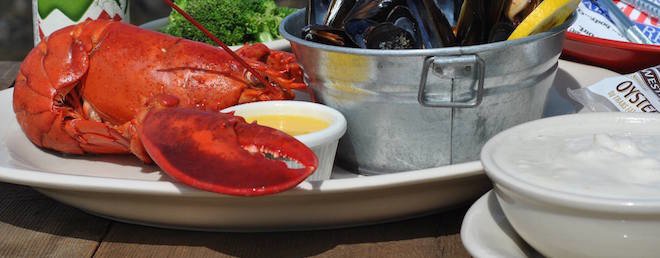From the Prison Yard to the Dining Room Table: The New England Lobster’s Triumphant Journey

Can you imagine buying New England lobster meat in a can, like tuna or spam? Or instead of packing your children PB&J, what if you sent them off to school day after day with lobster meat sandwiches? Or instead of buying Meow Mix, you let your feline feast on steaming, freshly caught New England lobster. While we find it hard to fathom this New England delicacy in a can, a child’s lunch box or a cat’s dish, back in colonial times, this was the norm. The New England lobster that is considered such a treat today was once considered the poor man’s protein, fed to servants and prisoners.
Lobsters in Abundance
In the early 1600s, lobster was so abundant it would wash up on the coastal beaches of New England, forming piles as tall as 2 feet high. The vast quantity of lobster littered all over New England beaches became known as “trash food.” Since there was so much of it, and people were turned off by its bug like appearance (resembling a scorpion), lobster was cheap. According to an article in psmag.com, John J. Rowan said in 1876, “Lobster shells about a house are looked upon as signs of poverty and degradation.”
Lobster was so detested, due to its bug-like resemblance, that many states had actual laws disallowing prisons to feed inmates lobster more than three times a week. In colonial days, lobsters were often cooked after they died, which may have been another reason the crustacean we know and love today was not nearly as appreciated or desired in past centuries. To eat them more than a few times a week was looked at as cruel and unusual punishment. Not only were the prisoners sick of the lobsters, but the fishermen were too. Crowding their nets and getting in the way of their catch, lobsters were a hassle, put aside to be used as fish bait or garden fertilizer.
Around 1820, a couple of centuries after the first lobsters were caught, the smack was invented — a boat with a wet well — which allowed fresh, live lobster to be transported from Maine to Boston and New York. The stage had been set, and the future of the New England lobster was in motion.
Getting Canned
By the mid-1800s, canning had become a popular technique by which to preserve the lobster meat and serve customers as far away as California. The first cannery was in Eastport, Maine. With a preservation technique in place and in production, lobster became a more lucrative commodity and the numbers of lobsters drastically decreased. Yet, while the customer base increased, the price of lobster stayed low, still largely seen as a pauper’s food. A can of Boston baked beans in 1940 would have run you 53 cents per pound, a fortune compared to a can of lobster which cost only 11 cents per pound.
In addition to canning, the railroad began to spread across the country. Visitors to New England who lived in landlocked states or more inland areas had never heard of the crustacean, and upon first bite, fell in love with the delicious meat. They were served lobster as if it was a rare and exotic delicacy, which to them it was, bringing in a nice premium for the transport managers and helping to change the lobster’s reputation.
In just one century, due in large part to the amount of canneries that popped up all along the coast, the once overabundant lobster had been overfished. Strict regulations were imposed, and by the end of the century, all canneries had left the states and moved north to Canada.
Wartime Rationing
Just when lobster had hit its stride and was fetching prices so high it had become a food only afforded by the upper class, the Great Depression began. People could no longer afford lobster, so without a home market, the government began using canned lobster to feed the troops abroad serving in World War II. Lobster wouldn’t lose its luster for long though. While many foods were rationed during wartime, Lobster was not. People began to buy it again, falling in love all over with the fresh Maine lobster… And the rest is history.
Today, New England lobster is one of the most sought after summer time treats. At Weathervane, we understand why and serve a number of lobster dishes including fresh fried lobster tails, single lobster dinners, lobster pie and every Thursday Wicked Cheap Twins – two lobsters for a wicked cheap price!


